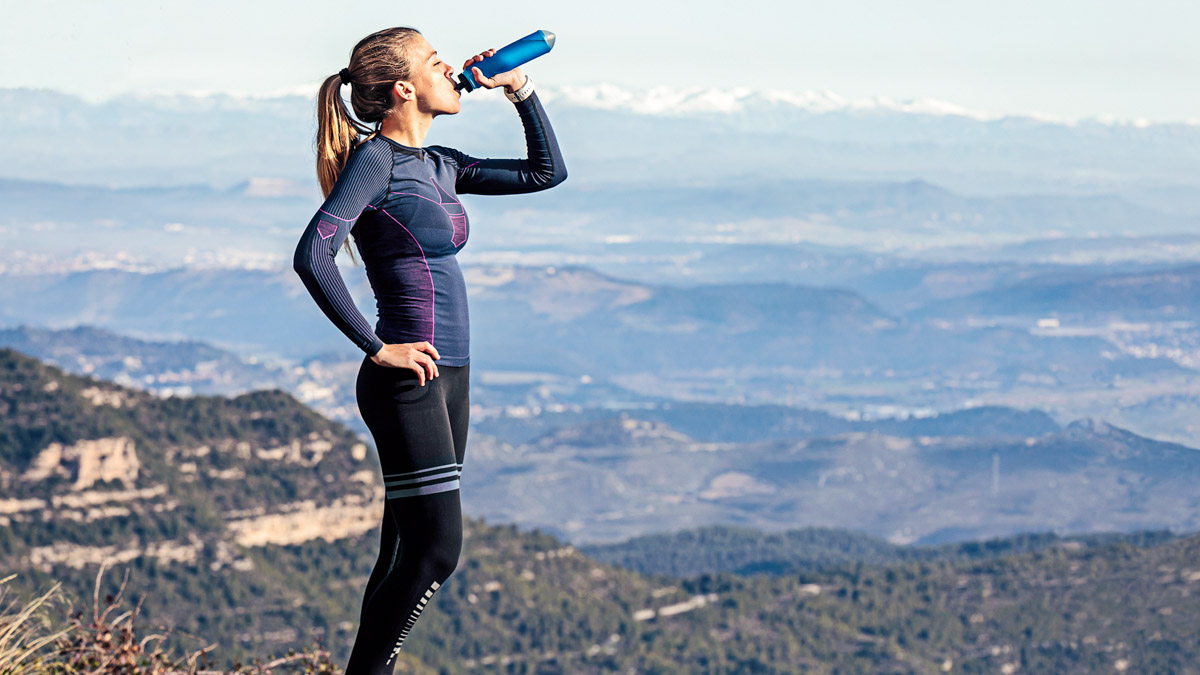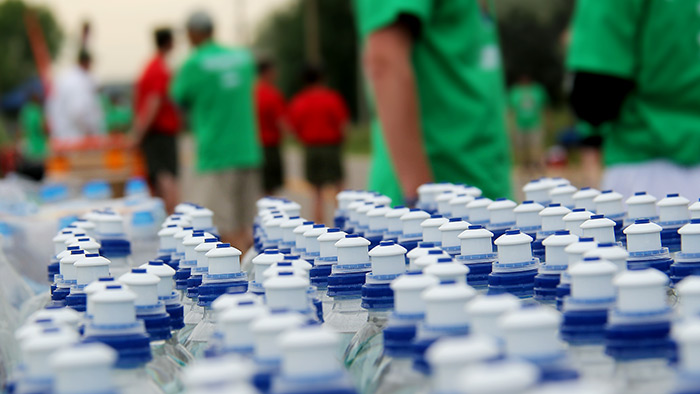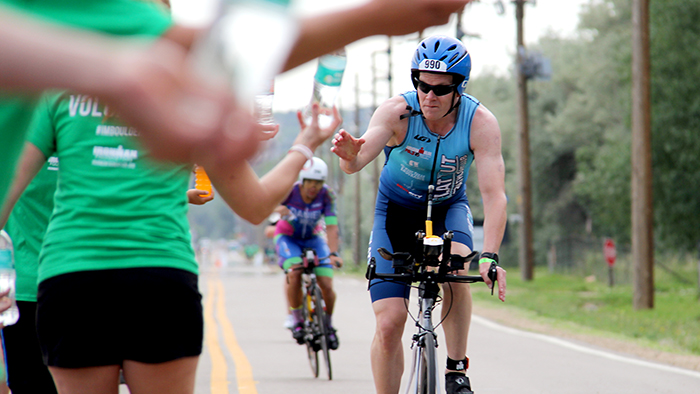When it comes to developing your own personal hydration plan, remember that there is not a one-size-fits-all approach. Athletes have individual sweat rates and, therefore, varying losses in sodium levels. Not only that, but your sweat rate is also impacted by the environmental conditions in which you train and race, such as the ambient temperature and the humidity.
These factors can also influence your sweat rate and will also be affected by how acclimatized you are—and even the clothing you are wearing. Plus there’s one large factor of your sweat rate that has been predetermined by your genetics and the aging process. So, how do we find our sweat rate?
How Do I Measure My Sweat Rate?
An easy way to measure your sweat rate is to weigh yourself (wearing no clothing) before and after a hard workout. The difference is your sweat loss—but that’s not the full picture. You also need to know how much water you took in. To do this, weigh your bottles before and after your workout. The difference is the volume of water you consumed (1 gram equals 1 milliliter). You can add volume of water consumed to your sweat loss, and divide by the total by the duration of the workout to get your sweat rate in terms of volume/time, usually denoted by liters/hour.
It’s important to test your sweat rate during different sessions and different periods during the year due to changes in weather. As you acclimatize and aerobically train, you will likely have an earlier onset of sweating, as it functions as the body’s cooling mechanism. Also, heat adaptation leads to a decrease in sweat rate over time.
For sessions under 90 minutes, for most people, it would be okay to drink according to thirst as long as you start well hydrated. However, an important question to consider is: how soon is the next session you need to be ready for? You may want to plan on hydrating like you would for a moderate to long endurance event.
How do I use my Sweat Rate to Plan Hydration?
Now that you know your sweat rate, you need to know what to do with it. Hopefully, you have learned by now we cannot replace 100% of our sweat losses without the chance of developing hyponatremia. In a 2017 study by Lindsay Baker with 500 different athletes, it was determined that most sweat loss is in the range of 0.5-2 liters. To simplify, sweat rate ranges are classified as low, moderate, or high. Now that you know your sweat rate in liters, you can determine your range. Most successful athletes, often through some trial and error, will have a basic hydration strategy nailed down based on their range.
- Low Sweat Rate < 1 liter
- Moderate = 1-1.5 liters
- High > 2 liters
For note, a liter is 33.81 ounces.
Although these are ranges, you need to know that body size matters. For a small female who sweats 1.5 L, even though that volume is considered moderate, it would likely be high for her body size. Have you ever done some heavy work with a larger guy and noticed how much more they sweat than you did? Yes, bigger guys have a tendency to sweat more.
To replace fluid losses, you should start with some ballpark estimates. If you have a low sweat rate of less than 1 liter per hour, you should start with 10-16 oz of fluids per hour. For moderate sweat rates of 1.0-1.5 liters, start with 20-24 oz per hour. This is the size of your typical cycling bottle. If you sweat more than 1.5 liters, you could need up to 34 oz per hour. Start with these
estimates, and then adjust based on the results.
How to Determine Your Sodium Losses
Next, you need to figure out how much sodium is lost in your sweat, as it’s the primary mineral to be concerned with. Recall that sodium loss is affected by the intensity of the workout and ambient temperature. An increase in either of these will increase your sodium losses. Also, please note that these losses are highly variable, anywhere from 5-15%. There are devices that can measure your sweat rate more precisely, even without actually sweating. When it comes to managing sodium losses due to sweating, we have to be careful because the rate of sweat sodium can outpace your gut’s absorption rate. That in itself can cause problems, such as an upset stomach and diarrhea.
There are a few questions you need to ask yourself to determine if you’re a “salty sweater” and have high sodium content in your sweat.
- Have you DNF’d more than once in a long endurance event?
- When you bike on the trainer, do you tend to leave a large pool of sweat underneath
- you?
- Do your eyes sting when you sweat?
- Do you have salt crystals on your clothes when you’re finished?
For those who appear to have a normal sweat sodium rate may, you want to start with about 1000mg of sodium per liter. If this leads to an upset stomach, consider lowering your intake down to 500mg, which is about the lowest point most people would want. If taking 1000mg doesn’t resolve your high sodium loss rate, then consider bumping it up to about 1500mg at the
most. You may need more depending on how much you’re losing and what your body can absorb. These are good starting points. (Note: If you’re using typical table salt as your sodium source, it’s made up of approximately 39% sodium and 61% chloride. As reference, 3 grams makes about 1170mg of sodium.)
For more precise measurements, you may want to consider a facility that uses Precision Hydration’s system to get absolutely dialed in on what you need.
Choosing the Right Drink for Your Performance Needs
After you know your sweat rate and how much fluid and sodium you need to manage it, you then need to figure out what types of fluids will work best. There are three types to consider: hypertonic, isotonic, and hypotonic drinks.
The “tonicity” of a fluid refers to its thickness, or how much solute has dissolved within the drink. The tonicity will affect your gut absorption rate. So, the more solute in the drink, the slower the absorption will be. This is why you have to find the right drink for you, and you may have to take some time to train your gut.
Isotonic drinks are your typical sports drink beverage, such as Gatorade, which is made up of 6-8% carbohydrate solution, containing approximately 445 mg of sodium per liter. Your typical sports drink is best for short, high-intensity competitions where replacing fluid may be more important than electrolytes. However, the sodium content in your typical sports drink is not enough even for the lightest sweater. Also, a problem with your typical sports drink is the solution of carbohydrate is too much for the gut to absorb for a lot of athletes. Some athletes will dilute this, but doing so also dilutes electrolyte content.
Hypertonic drinks, like flat Coca-Cola, work great at “waking” the body in the last few miles of the marathon in the Ironman. Coca-Cola has a high content of carbohydrates and/or other macronutrients, and it’s a 10% carbohydrate solution. That means you should wait until just the last few miles, because the fluid is thicker than your blood, so it will have a slow absorption rate and could upset your stomach.
Hypotonic drinks are your best solution for rehydration. Its lower carbohydrate content of 2-3% means it is rapidly absorbed into your bloodstream. Examples include electrolyte tablets. However, these are low in carbohydrates, which means they don’t exactly supply the best energy. If you’re drinking a hypotonic drink during an event, you will need to use other sources of carbohydrates. The good thing is that there are many hydration companies these days that are catering to endurance athletes and finding the right balance between solutions for all types of athletes with a 4-6% carbohydrate solution content carbohydrate solution rate.
Any of these types of drinks above can be used together if you feel you need more than one type of drink source. But, be sure to read the instructions and warnings on any drinks or additives before combining them, and always consult a physician before attempting any dietary change.
You can start out with any new hydration method in smaller increments in order to test how effective each will be for you personally. For example, if you are a light sweater, you can start with 10-16 ounces and see how it works, and adjust your intake by how you respond.
Now, you know how to find your sweat rate and how to start meeting your hydration needs.






